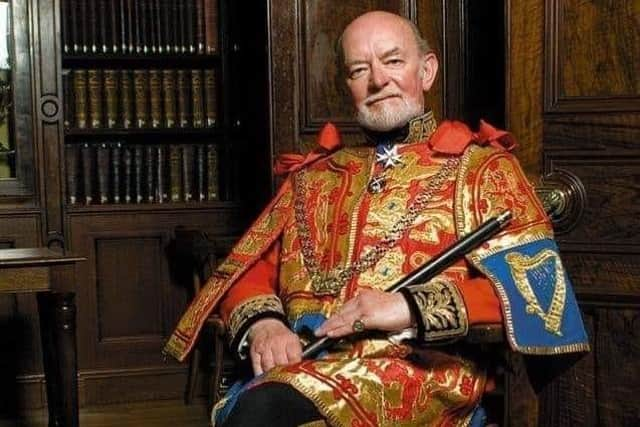Scotsman Obituaries: Charles Burnett, Scots heraldist who opened the door to ‘the gentle science’


When Charles Burnett founded the Heraldry Society of Scotland in 1977, he unconsciously crafted an entrée to a subject that had not always been a province for all. The upshot is a membership roll that today ranges from a baron to a bus driver, with a spin-off being an upward graph of growth of applications for coats-of-arms at the Court of the Lord Lyon.
A leading heraldist of his generation, he promulgated the message that the so-called “gentle science” is for all. Blessed with creative skills, he engineered exhibitions, established conferences, and in early days ran the Heraldry Society of Scotland almost single-handedly.
Advertisement
Hide AdAdvertisement
Hide AdNor were his efforts confined to Scotland, for he spread the word through lectures and presentations across four continents.
Charles had nurtured the notion of a heraldic society in Scotland from his early twenties. Following a mailshot from him of handwritten letters, some 40 people met in Edinburgh in February 1977, with Charles putting the question – should a heraldry society be created?
Thoroughly enthused by the positive response, he famously replied: “I’ll now write to The Heraldry Society in London, and let them know that they’ll have a branch in Scotland.” The resulting uproar rocked him, and he looked baffled. Then came: “Oh, so you want a separate Scottish society?”
Charles John Burnett was born in Aberdeenshire – he termed it “God’s own country” – in the fishing village of Sandhaven near Fraserburgh, his first memory being the sight of a swastika on a wounded German bomber during a raid on the Spitfire engine factory in Fraserburgh.
His creative talents showed early: at age 12 he organised a Coronation display at his primary school, and five years later Charles designed and built the display cabinet housing exhibits relating to Bishop Alexander Jolly, a local 19th-century rector.
In 1964, he conceived the costumes, setting and programme for the production of Sir David Lyndsay’s Thrie Estatis in Aberdeen – and it was here that he met his future wife, Aileen McIntyre from Portsoy in Banffshire.
From Gray’s School of Art in Aberdeen, he emerged with a degree in fine art, along with a penchant for smoking Gauloises.
His target of a career in design saw him selected in 1965 as one of the team designing and managing the British Pavilion at Expo 67 in Montreal. His abilities there came to the notice of the diplomat Paul Henderson Scott, who in his autobiography A 20th Century Life hailed Charles as “a talented designer, an enthusiast for heraldry, of infinite patience, good nature and robust common sense”.
Advertisement
Hide AdAdvertisement
Hide AdCareer posts included the National Museum of Antiquities of Scotland, Edinburgh (where one of his assistants was a young Muriel Gray); Scottish United Services Museum, Edinburgh Castle; and finally Chamberlain of Duff House, Banff.
Heraldically, his talents saw him appointed to office at the Court of the Lord Lyon in 1983, first as Dingwall Pursuivant and then Ross Herald five years later, a post he held for a near-record 22 years.
He was a proud Knight of the Order of St John, and with fellow heraldist and knight Henry Tilling produced a history of the Order in 1977 to mark the 30th anniversary of the re-founding of the organisation in Scotland.
Ever the individual, Charles ploughed his own furrow, refusing to learn to drive (“It’s something only servants did”); never failing to dress otherwise than immaculately; loathing sport; being passionately apathetic about Gaelic; and using Book Antiqua in blue as his personal typeface rather than the near universal black Times New Roman.
Proud of his Burnett heritage, he helped originate a Burnett Family Room within the caput of Crathes Castle on Deeside, adorning it with a score of hand-painted shields of notable Burnetts.
Charles went on to script and star in a short film introducing heraldry, shot at Crathes.
Through the monthly programme for the Heraldry Society of Scotland, he created a historic link in 1986 by inviting John Brooke-Little, then Norroy and Ulster King of Arms at the College of Arms in London. One of the curios of the Treaty of Union of 1707 is that in heraldry, Scotland and England remain foreign countries with entirely separate heraldic jurisdictions. Thus it was that Brooke-Little paid the first formal visit by an English herald to Scotland since a predecessor Edward Norgate, Windsor Herald, in 1639.
Lists of Charles’s events, creative ideas, exhibitions, lectures, books, articles and duties run to some two dozen pages, though he failed to record the litany of names he encountered through heraldic work, from Emperor Haile Selassie of Ethiopia and the Shah of Persia to Hollywood actor Kirk Douglas, plus members of the Royal family.
Advertisement
Hide AdAdvertisement
Hide AdEarly years in advertising taught Charles marketing through catchy designations. His exhibition of Scotland’s ancient currency in Edinburgh memorably drew record crowds thanks to his titling it “Angels, Nobles and Unicorns” – all of which are old Scots coins.
Charles adored family life. He was predeceased by his beloved Aileen, and is survived by his children Sara, Sandy, and Johnny, and grandchildren.
Charles could prove awkward, annoying and sometimes downright cantankerous. Colleagues and friends also remember him as innovative, creative, attentive, informative, amusing and endlessly helpful.
His legacy is that he brought more heraldry to wider audiences in the 20th century in Scotland than possibly any other single person.
Obituaries
If you would like to submit an obituary (800-1000 words preferred, with jpeg image), contact [email protected]